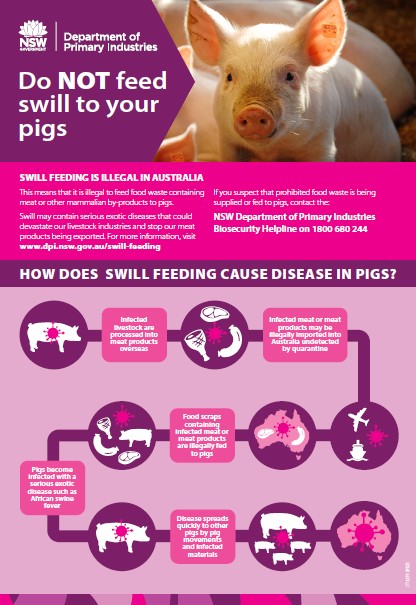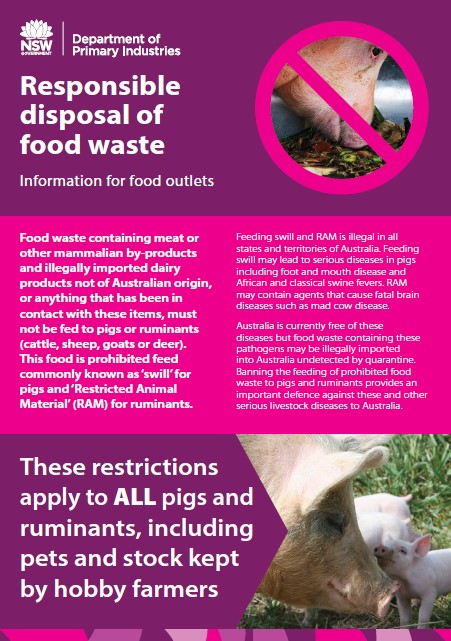Legal to Feed Pigs to Pigs
Did you know that feeding your pigs the wrong thing can have devastating consequences? Make sure you're helping to protect our export markets by knowing what you can feed to pigs!
Did you know that swill feeding is illegal in Australia? This means that it is illegal to feed food waste containing meat or other mammalian by-products to pigs.
Our Biosecurity Officers carry out regular inspections of piggeries, a role vital in protecting our pork industry and markets.
There are significant penalties if convicted of supplying and/ or feeding prohibited substances to pigs. To avoid the possibility of incurring these penalties, it's vital that you know what food waste is allowed to be fed to all pigs, farmed or pet.
Some food waste is classed as 'prohibited substance' which means it's illegal to feed to pigs in Australia.
Pig Nutrition
Managing pig nutrition ensures you have healthy and productive pigs.
Pigs need more than just pasture
Pigs are monogastric omnivores and eat plants, grain, fruits and insects. They love to dig and can destroy pasture if not rotated regularly. Several factors affect the nutritional value of the pasture, including the plant species, seasonal conditions and stage of growth of the pasture. Pasture is high in fibre, and the pig digestive system is not designed for lots of fibre.
- Pasture can only replace 3-15% of the ration of growing pigs.
- Young pigs need at least 90% of their dry matter from a grain based ration.
- Adult dry sows, gilts and boars can get up to 50% of their dietary requirements from good quality pasture, but still need a grain based ration.
- A mature dry sow of 250kg requires 2.5 – 3kg of grain-based ration for maintenance if fully housed.
- Requirements increase by 15% if the pigs live outdoors.
- Lactating sows require a full grain-based ration regardless of pasture availability.
Process cereal grain
Grain needs to be processed for efficient digestion. If fed whole, the grain will pass straight through the pig and be visible in their manure. Processing the grain changes it to a form that is easily digestible – rolled/ground/hammer milled. Soaking whole grains soften them and make them easier to chew. Troughs or bulk feed bins should be used rather than feeding on the ground.
One diet doesn't suit all pigs
For each stage of the pigs' life, they will have different nutritional needs. Piglets need a good intake of colostrum in the first 24 hours to provide antibodies to protect them against diseases and assist with gastrointestinal tract development. Good colostrum in the first 24 hours can double the survival rate of piglets that weigh less than 1.2kg at birth. From about 3 weeks old, piglets need more nutrients than they can get from milk alone. Creep feed should be introduced from about 10 days old, and creep feeders should be used from 3 weeks of age. Lactating sows should be fed as much as they can consume. This can be more than 6kg per day. Better fed sows leads to better fed piglets. Weaning can be done from 3-8 weeks. Weaning is stressful for the piglets and they must be fed at least twice a day. Feeders must be large enough so that all piglets can feed at the same time.
Formulate diets to suit pigs
A well formulated diet means the required amino acids, energy, vitamins and minerals are available to the pig. Most commercial pig diets are based on cereal grains and provide almost 40-50% of the required dietary protein. These cereal grains must have a protein supplement added that can supply the required lysine, threonine or tryptophan. Protein supplements can be plant based (eg. Soybean, lupin, canola meal) or animal based (eg. Meat meal, blood meal, milk powder). Amino acids cannot be synthesised by the pig, therefore they must be provided in the diet. Lactating sows are particularly susceptible to dietary deficiencies. Different feed ingredients provide different nutrients.
Cereal grains (wheat, barley, oats, sorghum, corn) are a good source of energy, but are low in lysine. Protein meals (soybean meal, canola meal) provide lysine and some energy, but are low in methionine. A good vitamin and mineral premix should be added to all diets at the recommended label rate. Poor diets can affect the health of you pigs. Lameness and cracks in the outer wall of the toes can indicate zinc and biotin deficiency. Calcium/phosphorus ration imbalance can lead to rib fractures.
An example of a basic diet for growers/finishers would include a cereal grain (60-80% of total ration), one or two protein supplements (eg. Soybean meal and canola at 5-10% of ration), synthetic amino acids (1-2% if needed), salt (1% - depends on water quality) and calcium plus phosphorus supplement (dicalcium phosphate, lime).
Fresh, cool water
Cool water should be available at all times. Pigs drink between 2.5-3.0 mls of water for every gram of food eaten. If troughs supply the water, ensure they are cleaned regularly. Pigs should have a clean water source that they can't wallow in. Pigs drink more in hot weather. In summer, provide shaded wallows for outdoor pigs where possible. Ensure small piglets have access to clean drinking water and are not forced to drink the wallow water.
Water must be kept cool. If using black polypipe, delivery lines must be insulated or buried at least 30mm deep. The ideal drinking temperature of water for pigs is 16 to 18°C and below 20°C in hot conditions. The water should be tested annually (kits can be obtained from your LLS Office) or whenever there is a change in the colour or turbidity and you suspect there may be a problem.
Prohibited substances and swill feeding laws
Prohibited pig feed includes anything that contains or has been in contact with meat. This includes household table scraps as well as commercial restaurant waste. Feeding infected prohibited pig feed (swill) can spread infectious disease which do not occur in Australia. It's also important to ensure that food substances you're feeding your pigs are clean and not contaminated with either antibiotic or pesticide residues.
What can't I feed to pigs?
Prohibited foods include:
- pies, sausage rolls, bacon & cheese rolls, pizza, deli meats, table scraps, etc
- any carcass (mammal or bird)
- the excreta or droppings of any mammal or bird
- household, commercial or industrial waste
- used cooking oil or fat or any substance that has been in contact or in the same container or storage facility as any of the prohibited substances.
What can I feed pigs?
Permitted foods include:
- non-meat bakery items
- fruit and vegetables
- cereals
- milk, milk products and milk by-products of either Australian origin or imported into Australia
- eggs.
Hazardous substances in feed and pasture
Hazardous substances are anything that is in the feed or pasture which may make the animal sick or cause injury or death. This includes mycotoxin contamination of mouldy feed, which may occur if the feed is stored in warm humid conditions, from grains from wet weather at harvest, hay or straw that was wet during hay making and grass or fodder silage. Mouldy feed should never be fed to pigs. Mycotoxin binders can also be added to their feed. Always check all feed carefully prior to feeding it to your pigs. Always ask for a vendor declaration whenever purchasing feed.
Feed testing can be undertaken if you ever have any concerns (feed test kits are available from your LLS offices). Become familiar with all plant species on your property as some plants are toxic to pigs. The seeds and flowers of two common shade trees, the white cedar tree (Melia azedarach) and the peppercorn tree (Schinus mole) are both toxic to pigs. Plants with sharp pointy seeds can cause injury and may result in abscesses.
Download our factsheet on pig nutrition PDF, 285.11 KB.
Feeding Pigs and Protecting Our Export Markets
Everyone has a role to play, whether you run a commercial piggery, have a pet pig or work in the food industry you need to know what you can feed to pigs and how to dispose of feed waste appropriately.
What is Swill Feeding?
Swill feeding is the traditional term used to describe the offering of food waste to pigs.
Swill feeding was once a common practice to reduce the costs of feeding. This practice is now banned in all states and territories including New South Wales. The ban was implemented to reduce the risk of a serious exotic disease breakout in Australia. Swill feeding was found to be the cause of the devastating Foot and Mouth Disease (FMD) outbreak in the United Kingdom in 2001.
 Swill feeding is illegal in Australia. This means that it is illegal to feed food waste containing meat or other mammalian by-products to pigs.
Swill feeding is illegal in Australia. This means that it is illegal to feed food waste containing meat or other mammalian by-products to pigs.
Swill may contain serious exotic diseases that could devastate our livestock industries and stop our meat products being exported.
For more information, visit the NSW Department of Primary Industries (DPI) website.
If you suspect that prohibited food waste is being supplied or fed to pigs, contact the NSW Department of Primary Industries (DPI) Biosecurity Helpline on 1800 680 244.
How does swill feeding cause disease in pigs?
- Infected livestock are processed into meat products overseas.
- Infected meat or meat products may be illegally imported into Australia undetected by quarantine.
- Food scraps containing infected meat or meat products are illegally fed to pigs.
- Pigs become infected with a serious exotic disease such as African swine fever.
- Disease spreads quickly to other pigs by pig movements and infected materials.
Download the infographic (NSW DPI). PDF, 916.88 KB

Feeding swill and RAM is illegal in all states and territories of Australia. Feeding swill may lead to serious diseases in pigs including foot and mouth disease and African and classical swine fevers. RAM may contain agents that cause fatal brain diseases such as mad cow disease.
Australia is currently free of these diseases but food waste containing these pathogens may be illegally imported into Australia undetected by quarantine. Banning the feeding of prohibited food waste to pigs and ruminants provides an important defence against these and other serious livestock diseases to Australia.
Download the factsheet Responsible disposal of food waste (NSW DPI) PDF, 706.59 KB
Source: https://www.lls.nsw.gov.au/what-we-do/our-major-projects/every-bit-counts/archived/livestock/pigs/what-can-i-feed-my-pigs2/do-not-feed-swill-to-your-pigs-infographic
Post a Comment for "Legal to Feed Pigs to Pigs"